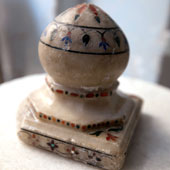• Tools:
The tools required for carving are few and simple and were initially custom made by the blacksmiths in Alwar. Today these tools are easily available in market. Following are the tools used in the process:
Hatodi (Hammer):
The hammers of different sizes are used for different purposes. They are used to hit the chisel for carving. The wooden head hammer is used for soft strokes to get fine details. The ones with big metal heads are used for initial removing of the stone. Later small head hammers are used for detailed and intricate works/ motifs.
Chheni (Chisel):
An iron tool with sharp and flat-edge is used initially for removing unwanted material to get a rough outline on the stone. Two types of chisel; flat and round headed are used for specific purposes. Round chisel is used for minute or detailed work- usually for carving ornaments, face, eyes etc.
Drills:
Artisans use a lot of machine tools to get fine details and also to decrease the time to make the product. Drills are used to carve out fine folding of the garments and other facial expressions. Mainly sophisticated machine tools are used, as they are durable and safe.
Planer:
This is used for smoothening the rough edges, whenever required.
Files:
Stone filers are used to file the surfaces. These files come in various grades of roughness.
Buffing Machine:
This is used for finally smoothening/ polishing the surface. It has rings of stitched cloths of different grades of fineness.
Aari (Saw):
This is used for cutting the stone slabs into the required sizes.
Lathe Machine:
These are huge machines used to make circular, cylindrical or hemispherical stone products.
Prakaar (Compass):
Compass is used for making marks on the stone surface.
Scale:
A Scale is used for measuring and marking.
Right Angle:
This is used to make perfect angles on the stone for making cuboids or cube.
Brush:
Brush is used for cleaning the stone powder which collects on the outer surface of the statue while carving out details.
Blower:
This is used to blow away the stone dust from the statue especially from those parts where the brush cannot reach or when dust collects on the inner parts of the statue.
Pencil or Markers:
Pencils and markers are used to sketch rough outlines on the stone before the chiseling process starts.
Rubber Pipe:
This is used to supply water to the stone and machine whiles the drilling work takes place. Water helps in preventing the dust to fly.
• Raw Materials:
Jaipur is the center of marble craving in the state. The raw materials used in stone carving are as follows:
Safed Pathar (White Marble):
Marble is the main raw material and is available in many shades and qualities across Rajasthan. Ajmer, Jaipur, Jodhpur, Bikaner and Udaipur represent the hub of marble in the state. The finest quality marble in the country is mined at Makrana. They are mined in the form of big boulders. The quality of the marble is defined by its whiteness and density. The less porous marble is more superior in quality and hence more expensive. Since the best of the marbles are exported so the artisans have moved to other options. They use a super white stone procured from Vietnam. This stone is imported to Rajasthan and then the artisans buy it from big suppliers/sellers. The rate starts from 1 lakh/ton and increase with the fineness and quality. Artisans buy marble from Alwar, Makrana or Ambaji.
Varak (Silver and Gold Foil):
Varak is used for applying on the idols. Jewelries and borders of cloth are ornamented with real or artificial Varak. This is applied with the help of chemicals.
Acrylic or Oil Paints:
Chemical colors are used to paints floral patterns on the products as a substitute to gold, silver and other precious stones.
Precious stones:
A lot of colorful precious stones are used for inlay work. These stones are cut and the inlay work is done by the artisans themselves.
Regmaal (Sandpaper):
Sand paper is used for smoothening/polishing the rough surface in order to give the final touches to the carved pieces.
Wax Polish:
Once the product is made it is polished with wax. Marble is a porous stone therefore to prevent it from absorbing any liquid it is polished wax.
Araldite:
Araldite is used to stick the broken pieces together. It is available easily in the market.
Geru (Red Soil):
This is used for marking on the marble while finishing. Once the product finished it is rubbed and washed off.













